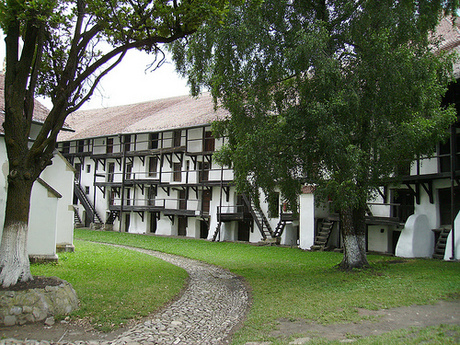Prejmer
Prejmer (German: Tartlau; Hungarian: Prázsmár) is a commune in Braşov County, Romania. Composed of three villages (Prejmer, Lunca Câlnicului and Stupinii Prejmerului), it is located 18 km northeast of Braşov. Prejmer Fortified Church is one of a series of UNESCO-listed historic churches in Romania and is known for being the largest church of its kind in south eastern Europe. Built from 1212 and completed in 1225, Prejmer Fortified Church was a construction of the Roman Catholic Teutonic knights.
With its thick circular walls rising 40 feet, advanced weaponry and underground passageways, Prejmer Fortified Church was heavily defended, demonstrating the turbulent nature of the region at the time. The fortress was in fact subject to fifty sieges, only one of which resulted in its capture. This occurred in 1611, when it was taken over by the Prince of Transylvania, Gabriel Báthory.
The Teutonic Knights constructed the fortress Tartlau in 1212–1213 as part of their colonization of the Burzenland region. The town of Prejmer near the castle had begun development by 1225, and was the eastern-most settlement of the Transylvanian Saxons. Prejmer was repeatedly invaded throughout the Middle Ages by various groups, including the Mongols, Tatars, Hungarians, Ottoman Turks, Cossacks, and Moldavians. However, the castle was only captured once, by Gabriel Báthory in 1611. Most of Prejmer's German population fled the town during World War II.
Prejmer is noted for its fortified church, one of the best preserved of its kind in Eastern Europe. Between 1962–1970, the Romanian government carefully restored it to its present condition; the restoration work was done under the direction of architect Mariana Angelescu and engineer Alexandru Dobriceanu. The church is modeled after churches of Jerusalem, as well as built in the style of Late Gothic churches from the Rhineland. In the 15th century, it was surrounded by a wall 12m high, forming a quadrilateral with rounded corners. The wall was reinforced by four horseshoe-shaped towers, two of which have since disappeared. The entrance—a vaulted gallery—is protected by a barbican and flanked by a lateral wall. The defensive structure is strengthened by embrasures and bartizans, while the covered way is surrounded by a parapet. The granaries and rooms that accommodated the villagers are arranged on four levels above the cellars.
The beginnings of the Holy Cross Church in Prejmer relate to the rule of the Teutonic Knights in Barsa Country (1211-1225). Widely considered as the most powerful peasant fortification in medieval Transylvania, the fortress encompassing the church in Prejmer was built between the 15th and the 16th centuries. In 1240, the church and its associated domain were repossessed by the Cistercian monks. Erected in the 13th century in early Gothic style, the church is a Latin cross-plan building with an octagon tower rising over the nave, ogival vaults and side chapels that flank the polygonal-shaped main apse
On the outside, reflecting Cistercian Gothic-style influences from the abbey in Carta, are windows with quatrefoil tracery and a console frieze beneath the cornice.
Between 1512 and 1515, the church was transformed by enlarging western wing and covering it with a ribbed vault. Inside the church, a valuable polyptych altar depicting the “Passion of the Christ” dating from the mid 15th century has been preserved. The double-fortified inner ward forms an ellipsa with four horseshoe towers completed by a barbican, and was fit with one of the most advanced systems of provision chambers that can be seen in a Transylvanian fortified church. Inside the walls, the village community had all the supplies needed to withstand a prolonged siege.
The first documentary to Prejmer village is from 1240. Organized around a central square that encompasses the fortress-church, the village has almost completely retained its historical layout and structure, as well as the architecture and decoration of the houses, most which were built between the end of the 18th century and the beginning of the 20th century.
In 1520, the village of Prejmer was the largest settlement in Barsa Country, and its present-day structure was completed around 1556. The village preserves ethnological and historical values illustrating the life of a multi-ethnic community.



